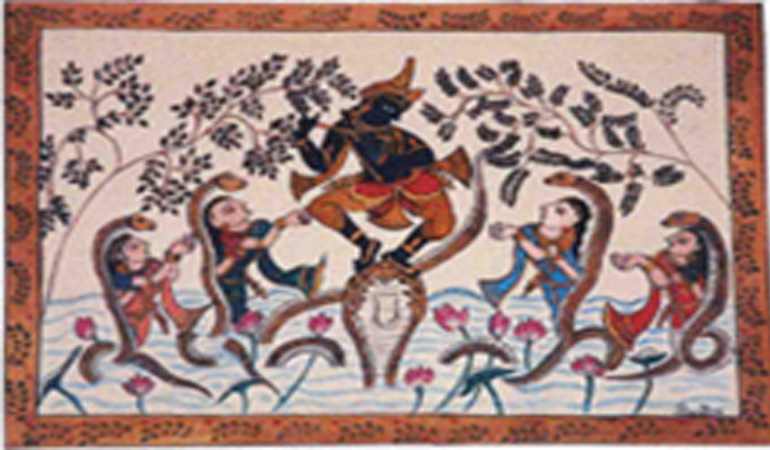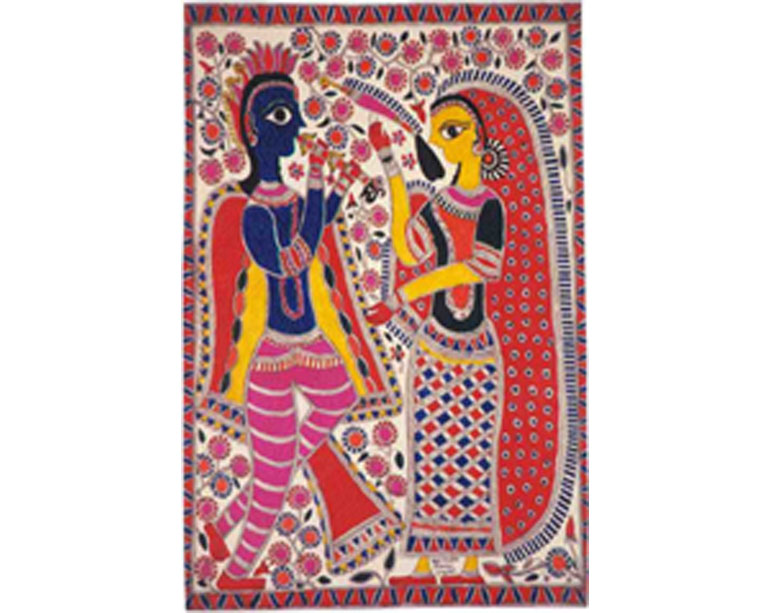Introduction
Traditional Folk styles
Folk art in India is rich, expressive and colourful. It has existed in villages since time immemorial. It expresses profound philosophy spelt out in ancient scriptures. The art is decorative, ritualistic and, wrapped up in mythology. Regions of India have produced their own styles with religious themes, involving meticulous details with refined lines and, simple as also grotesque and weird figures. Communities were insulated from outside influence and thus developed art that was meaningful to them. Hereditary nature of the occupation of artists and their isolation has resulted in continued existence of a unique style in that region.
From earliest times informal centres of religious art and literature emerged at locations where there was a ‘project’ like construction of a temple. Religious teachers knowledgeable in scriptures, poets, painters, musicians, epic performers etc. from villages converged and stayed together for sometime. This meeting made possible exchange of knowledge and led to survival of myths, history and folk art etc. While style remained the same, art became richer.

Pata Paintings Orissa
Artists make paintings on temple walls and on cloth. Called chitrakars in Orissa. Chitrakars have worked in temple of the triad Jagannath, Balbhadra, and Subhadra in Puri. Just before rath yatra or car festival three wooden idols of the triad are taken behind closed doors to be freshly painted by chitrakars. In this period, image of triad is painted on new cloth and hung on doors for prayers. These artists also do smaller paintings on religious themes.
Madhubani Paintings
Madhubani paintings are created from house to house. Through them, religious symbolism is expressed. In Mithila, women folk of all communities paint. Madhubani paintings are primarily wall paintings like frescoes. Most famous are kohber paintings (marriage alpana). The central theme is love and fertility. Passion, love and desire are reduced to symbols to suggest and evoke mood, to create an atmosphere and environment. Paintings are done by ladies at home as a useful and absorbing past time.

Chitrakathi Paintings(Maharastra)
Chitrakathi denotes a community of migrating story tellers found all over Maharashra and some parts of Andhra Pradesh and Karnataka. They make series of single sheet paintings All paintings on one story are bundled in a pothi. Theme of a Chitrakathi painting includes stories on local versions of Ramayana, Mahabharata and mythical themes. Use of brownish tones of stone colours gives a remarkable effect. Figures in paintings generally stylized.
Kalamkari(Andhra Pradesha)
Tradition of Kalamkari painting is very old. The word kalam is of Persian origin meaning a pen. Fine craftsmen of pen and brush technique painted narratives of religious legends from which people learnt stories of gods. A feature of kalamkari painting is the profuse adornment of the figure with meticulous details.
Thanjavur Painting
These are from south India. The style was essentially of Tamil origin but it spread gradually to Andhra Pradesh and to Karnataka. This art is the product of artisans from traditional families. They were commissioned by devotees to make paintings of Hindu Gods mainly infant Krishna. This folk art is patronised by the affluent who have custom made paintings created which are adorned with gold and precious stones.

Kalighat Painting
Kalighat is a place of pilgrimage. It is a center of art with a distinct style of Indian paintings known as Kalighat pata painting. Kalighat painters are mostly Bengali Hindu of pata community, who came from rural Bengal to Calcutta and found in Kalighat a center which could sustain them. Their work was religious in nature and puranic in content. The subjects were usually mythological and gods and goddesses. Painters used local paper which was thin and cheap and water colour easily available in the city.
Kalighat painters had been produced paintings for mass scale to the pilgrims who thronged Kalighat Temple. With their bounding lines and bold rhythms they were close to the ancient murals of Ajanta and Bagh. The same quality of lines and rhythm, linked with powerful colours, displayed a surprising affinity with modern art.

